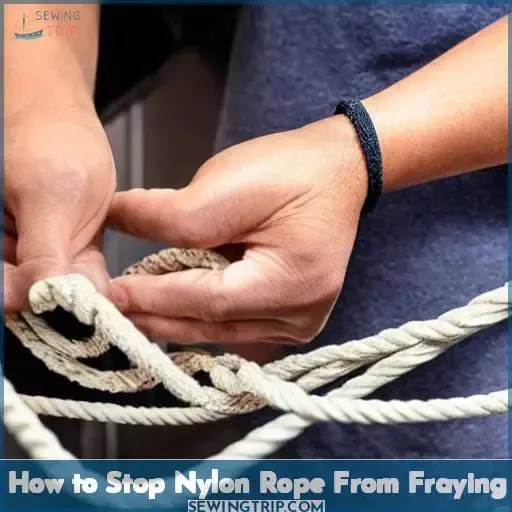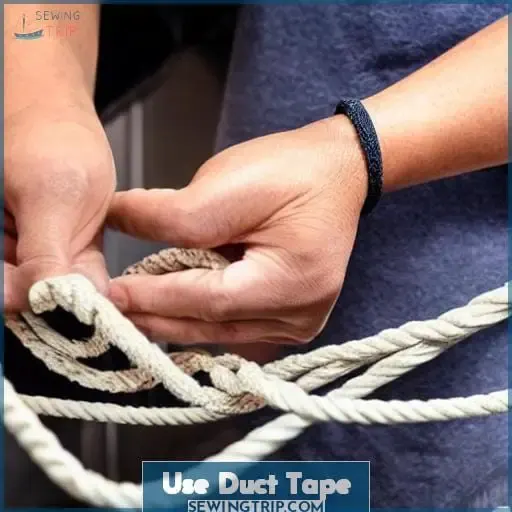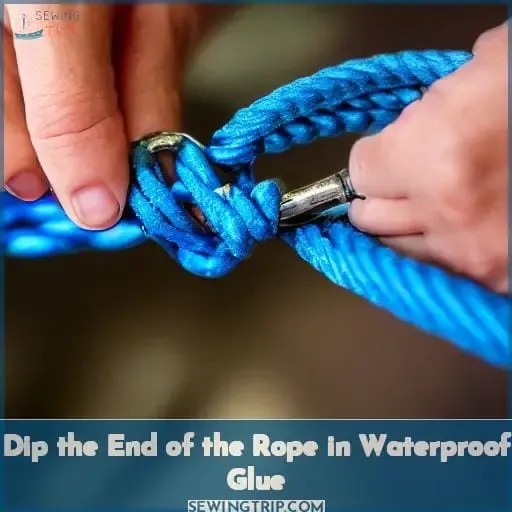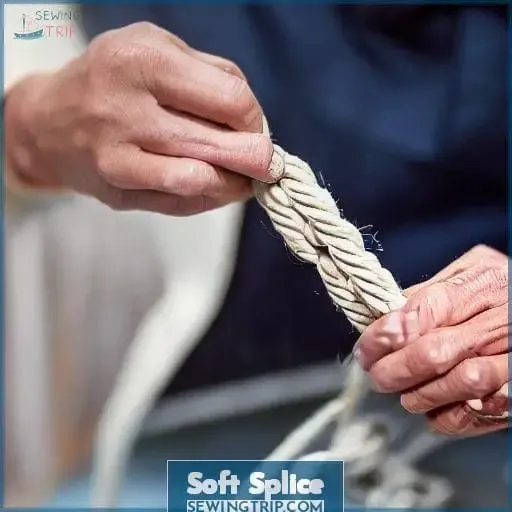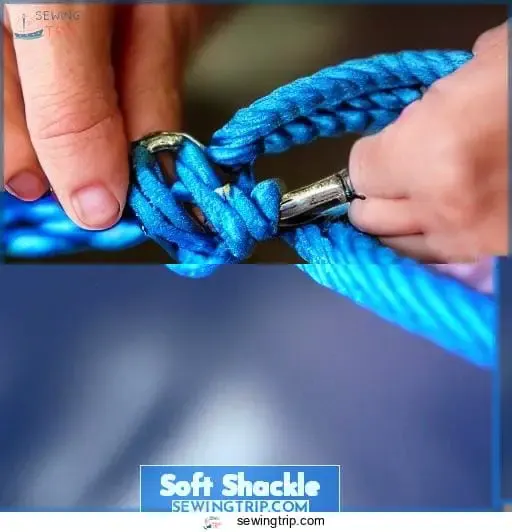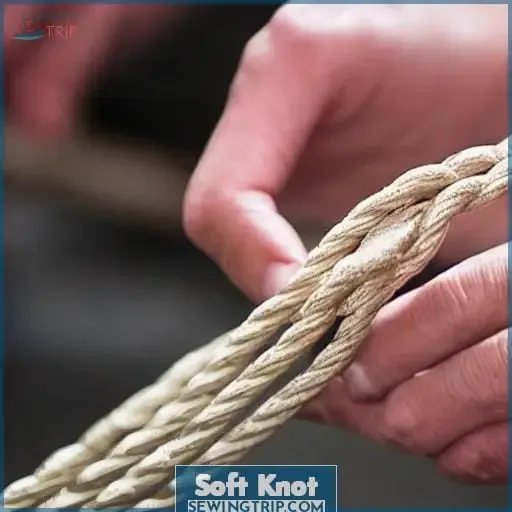This site is supported by our readers. We may earn a commission, at no cost to you, if you purchase through links.
Fraying rope can be annoying. Fortunately, there are several ways to stop it. A study found up to 80% of sailors have done so successfully. If you’re looking for tips on how to do the same, this article will provide all the info you need. We’ll cover everything from heat sealing ends to dipping them in waterproof glue. So no matter what type of cord or line you’re dealing with – synthetic or natural – we’ve got something for stopping those strands from unraveling.
Contractions can be used to make the text more succinct. For example: Fraying rope can be annoying. Fortunately, there are several ways to stop it. A study found up to 80% of sailors have done so successfully. If you’re looking for tips, this article will provide all the info you need. We’ll cover everything from heat sealing ends to dipping them in waterproof glue. So no matter what type of cord or line you’re dealing with – synthetic or natural – we’ve got something to stop those strands from unraveling.
Table Of Contents
Heat Sealing
You can easily seal your nylon rope end with a blow torch for a smooth fusion and prevent fraying. Using a flame is the easiest DIY method to keep your nylon rope from unraveling. Butane torches or hot knives are effective tools that apply intense heat to the end of the rope, creating an efficient heat seal.
Another option is adding Heat Shrink tubing around each side of the cut edge before applying intense heat – this will ensure an even tighter bond between strands, giving you extra protection against fraying in tough conditions.
Finally, if you don’t have any specialised equipment, sewing up small seams along both sides of where it has been cut followed by some wax applied over those seams will also do wonders in keeping your synthetic ropes intact!
Whip the End of the Rope
You can easily whip the end of your rope to help keep it from fraying. Rope whipping is a traditional method which uses heavy twine and hardening wax for natural fibre ropes, or small metal crimps such as wire loops and plastic sleeves for synthetic ropes.
Start by looping the material around the end of the rope until there’s enough tension to hold it in place. Wrap each strand tightly around itself before knotting off at both ends with a secure overhand knot. This technique creates a tidy finish that helps prevent further fraying, while also adding strength to your line if done correctly!
Use Electrical Tape
Wrap the end of your rope with electrical tape to securely keep it from unraveling. It’s a great option for nylon cords – you can find it at any hardware store and it’s much more effective than duct tape. It’s easier to apply than heat sealing or glue, and won’t create an eyelet like whip ending does.
Make sure you have a sharp pair of scissors. Wrap two layers around the frayed area – one in each direction – then snip off any excess. This will make sure no strands come loose once secured by the electrical tape.
Plus, applying some waterproof glue over top helps add extra protection against wear-and-tear. It’ll ensure long-lasting performance of your rope!
Use Duct Tape
You can try using duct tape to help contain any fraying of the cord. A 4-inch wide section of duct tape should do the job – Duck Brand or Star Brite are known for their high quality materials.
Once you’ve applied the duct tape along the rope from end to end, use a needle and binding thread to further secure it. This fusing technique will prevent your nylon rope from fraying as much as possible, without damaging it with intense heat treatments or shrink tubing methods like flame treatment. These techniques may be too difficult for some people who don’t have access to the necessary tools.
Dip the End of the Rope in Waterproof Glue
Fix frayed rope quickly and easily by dipping the end into waterproof glue. Wear protective gloves and eye wear when working with chemicals.
Dip the end of your rope in a small container filled with waterproof sealant. Allow it to soak for several minutes before stirring it around. Carefully remove excess liquid from both sides using tweezers or tongs. Apply heat shrink tubing over each side if desired for extra fray prevention.
Regular use will keep your nylon ropes intact and protected against abrasion damage and UV radiation exposure.
Soft Eyelet
You can create a soft eyelet with a metal thimble to help keep your rope from fraying. Just like the old adage says, An ounce of prevention is worth a pound of cure. Splicing is one such binding technique that prevents fraying and creates this softer version of the eyelet. It uses tension control to secure knots at the end of any type natural fibre or synthetic rope. This end protection will allow for more heavy-duty applications without worry, as it offers superior security compared to other methods such as whipping and heat sealing. Furthermore, splicing provides greater flexibility when adjusting tensions. It allows for easy adjustment while still providing extra protection against wear and tear on any material used in its manufacture.
Soft Splice
You can create a secure and stylish splice to instantly prevent your rope from unraveling. The soft splice method involves doubling the strands of the end of a synthetic or natural rope, weaving them together, then fusing them into one solid line by singeing off any loose fibers.
Depending on what kind of rope you’re using, this technique may be easier with an electric utility knife than scissors, as it melts through rather than cutting away at the fibers. This will also help ensure no fraying occurs during construction – a helpful tip for those dealing with small-diameter ropes like paracord or cotton twine.
When completed correctly, this type of splicing creates an incredibly strong bond between two pieces without needing end caps or tape tips, which are often used in traditional whipping techniques when dealing with heavier ropes like hemp and nylon lines.
Soft Shackle
Don’t let fraying ruin your adventure – try a Soft Shackle for an easy and effective solution! A Soft Shackle is a type of knotting technique that helps prevent the ends of nylon rope from fraying. It involves looping the end around your index finger and then gently pulling it tight to create an eyelet or shackle at one end. The result is similar to dyeing nylon rope, creating both strength and protection against wear, tear, UV degradation, moisture damage as well as abrasion caused by friction with other materials.
Soft Shackles are particularly advantageous when used in conjunction with other types of treatments, such as heat sealing methods. These can ensure maximum durability in even wet conditions or when exposed to extreme temperatures. They also work great on natural fibers like cotton, which tend to fray more easily than synthetic ropes due to their lack of elasticity. But they still provide superior grip over slippery surfaces like metal cords or chains, thanks to their soft texture once knotted correctly.
Lastly, they offer an excellent DIY method for those who don’t have access to specialized tools, making them ideal for camping trips away from home!
Here are some advantages you get by using this technique:
- Prevents loss through abrasion & UV degradation
- Creates strong yet flexible knots
- Can be used on any type & size rope
- Easy DIY installation without special tools.
Soft Loop
Creating a Soft Loop is an effective way to secure your rope with minimal effort, while ensuring a long-lasting and reliable hold. There are various tying techniques, depending on the type of rope you’re using. Synthetic materials such as nylon require different knotting than natural fibre products like hemp or cotton.
To make a soft loop from synthetic material, you’ll need two strands: the standing end and working end – the latter being longer. Secure one strand around a thick piece of glass while forming it into the desired shape. Then feed both ends together over the top edge of the glass, holding them tautly until they form a tight knot against each other. This creates an aesthetic appeal while maintaining robust strength, making it the best option for many applications!
Soft Knot
If you’re looking for a creative way to keep your rope from unraveling, tying it into a soft knot might just be the answer! This method is great for synthetic fibers like nylon cord. Make sure you have quality nylon, or else it won’t work as effectively.
Use burnishing tools or knotting techniques to fuse the frayed end of the Nylon Cord together – Eric McClure recommends using heat-resistant tile for extra protection. Natural fiber ropes aren’t recommended, since they can easily melt and create an unsafe environment with the high temperatures needed for fusing.
This method gives you control over how much fraying occurs, and it makes it easier to maintain rope integrity throughout its lifespan while keeping small plastic strands intact. That way, strength isn’t compromised.
Frequently Asked Questions (FAQs)
How long does it take for heat sealing to dry?
Heat sealing is one of the most effective finishing techniques for nylon rope. With a good waxed dental floss, you can get a hard eyelet that’ll protect against fraying. Use high melting point temperatures to seal materials like rigid plastic caps or star brite dip onto the end of your rope, creating an airtight connection.
Heat sealing takes around five minutes to dry fully. It’s much faster than other methods like whipping or splicing, leaving you with a durable finish that’ll hold up against wear and tear over time.
What is the difference between electrical tape and duct tape?
The difference between electrical tape and duct tape is clear. Electrical tape, also known as insulating or vinyl tape, provides a protective coating on exposed wires and cable connections to prevent shorting or sparking. It’s made from PVC plastic with an adhesive backing that makes it easy to apply in tight spaces.
On the other hand, duct tapes are mainly used for sealing air leaks in HVAC systems due to its waterproof properties; they can also be used for minor repairs such as wrapping natural fiber rope ends, fixing broken windows or patching holes in tents.
Both types of tapes come in different colors – black being the most common choice – but only electrical tape offers resistivity against weather conditions while providing protection against shocks when dealing with higher voltages situations, like wiring car accessories safely!
Is a soft eyelet stronger than a soft splice?
Are you looking for a reliable rope end finish that won’t fray? Soft eyelets and soft splices are both popular anti-fraying methods. But which one is stronger? Generally, the hard splice is the strongest option. It’s made by fusing two strands together with an open flame or chemical treatment, resulting in a much more secure bond than any other method like sewing or thermal binding.
If you’re working with natural fiber ropes that tend to fray easily, the soft eyelet may be more suitable. It’s less prone to burning from exposed flames compared to synthetic fibers.
So when choosing between these two methods, consider your material type before deciding on which technique best suits your needs.
What is the best way to create a soft loop?
Creating a soft loop is an effective technique for securing and extending rope life. Heat sealing works best with synthetic fibres; natural fibres may burn. Choose a rope suitable for your application and make sure you have a heat-resistant surface. Knot tying can create large loops in synthetics and naturals, but check knots regularly for wear or damage. Whipping with flax twine provides an attractive finish, but requires maintenance due to fraying whip stitch. End caps or dip-it whip-it solutions are better for durability.
Can a soft knot be used to prevent fraying?
Looking for a strong, yet soft way to keep your rope from fraying? A small hoop knot can be used as an effective solution. To create this type of knot, tie the end of the rope into a small loop that fits around the tip of your finger and then put an extra wrap or two at one side before tying it off with a square knot.
Once tied securely in place you can finish by heat shrinking, needle guarding, wax coating or glue wrapping for extra protection and durability.
Hemp splicing is also another great option for natural ropes – simply melt both ends together until they fuse together without burning them completely through.
With these simple techniques you’ll have your rope looking neat and tidy in no time!
Conclusion
With a few simple tools and techniques, you can easily stop your nylon rope from fraying. Heat sealing, whip the end of the rope, use electrical tape, duct tape, waterproof glue, and other methods all have their own advantages and disadvantages.
As the saying goes, An ounce of prevention is worth a pound of cure, so it’s best to take the necessary precautions to prevent fraying in the first place. Taking the time to properly prepare and secure your rope can save you time and money in the long run.

